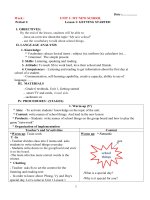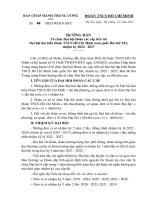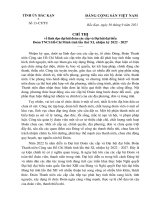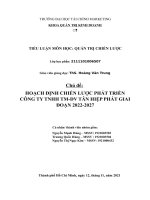Sample global feminine hygiene market 2022 2027 mordor intelligence
Bạn đang xem bản rút gọn của tài liệu. Xem và tải ngay bản đầy đủ của tài liệu tại đây (1.19 MB, 36 trang )
SAMPLE
GLOBAL FEMININE HYGIENE
MARKET (2022-2027)
The study offers:
•
A detailed understanding of the current market dynamics and growth opportunities
•
An impact of rapid developments on the market
•
An overview of the competitive intelligence, with product innovations and strategies of the major players
•
An assessment of the impact of COVID-19 on this industry
ICTGoods
Domain:Domain:
Consumer
Base Year: 2021
2018
ForecastPeriod:
Period:2022-2027
2019-24
Forecast
Industry Reports | Consulting | Intelligence Center
+1 617 765 2493 | | www.mordorintelligence.com
DISCLAIMER
Any information and/or material provided by Mordor Intelligence, including any or all the analysis and/or research from Mordor Intelligence, are
provided to a select group of customers in response to orders for, such information, material, analysis, and/or research. As a customer of Mordor
Intelligence, you acknowledge that our information, material, and/or services are for your internal use only, and not for any external use and/or
dissemination, or general publication and/or disclosure to any third parties.
Any or all the information and/or material provided by Mordor Intelligence are based on primary interviews and/or secondary research and are,
therefore, subject to fluctuation and variance. Mordor Intelligence takes no responsibility for any incorrect information and/or material supplied
to us by sources we rely on, and no part of our analysis or research may be given, lent, resold, or disclosed to any third parties, including noncustomers, without explicit as well as written permission from Mordor Intelligence.
Unauthorized reproduction and/or transmission of our information, material, analysis, and/or research in any form and by any means, including
by photocopying, mechanical/electronic recording, or otherwise, without the explicit and written permission of Mordor Intelligence, is expressly
and clearly prohibited.
Any use of the information, material, analysis, and/or research provided by Mordor Intelligence is at your sole risk; you acknowledge that the
information, material, analysis, and/or research is provided “as is”, and that Mordor Intelligence provides no warranty of any kind, expressed or
implied, with regard to the information, material, analysis, and/or research, including, but not limited to, merchantability and fitness for any
purpose and/or use.
2
SAMPLE– GLOBAL FEMININE HYGIENE MARKET
TABLE OF CONTENTS
5.2 By Distribution Channel
1. INTRODUCTION
1.1 Study Assumptions and Market Definition
5.2.1 Hypermarkets/Supermarkets
1.2 Scope of the Study
5.2.2 Convenience Stores
2. RESEARCH METHODOLOGY
5.2.3 Drug Stores/Pharmacies
3. EXECUTIVE SUMMARY
5.2.4 Other Distribution Channels
5.3 By Geography
4. MARKET DYNAMICS
5.3.1 North America
4.1 Market Drivers
5.3.1.1 United States
4.2 Market Restraints
4.3 Industry Attractiveness - Porter's Five Forces Analysis
4.3.1 Bargaining Power of Suppliers
4.3.2 Bargaining Power of Buyers
4.3.3 Threat of New Entrants
4.3.4 Threat of Substitutes
4.3.5 Intensity of Competitive Rivalry
5. MARKET SEGMENTATION
5.1 By Product Type
5.3.1.3 Mexico
5.3.1.4 Rest of North America
5.3.2 Europe
5.3.2.1 Germany
5.3.2.2 United Kingdom
5.3.2.3 Italy
5.3.2.4 Spain
5.3.2.5 France
5.1.1 Sanitary Napkins/Pads
5.3.2.6 Russia
5.1.2 Tampons
5.3.2.7 Rest of Europe
5.1.3 Menstrual Cups
5.1.4 Other Product Types
3
5.3.1.2 Canada
SAMPLE– GLOBAL FEMININE HYGIENE MARKET
5.3.3 Asia-Pacific
5.3.3.1 China
TABLE OF CONTENTS
5.3.3.2 Japan
6.3.5 Essity AB
5.3.3.3 India
6.3.6 Ontex Group
5.3.3.4 Australia
6.3.7 Edgewell Personal Care
5.3.3.5 Rest of Asia-Pacific
6.3.8 Unilever PLC
5.3.4 South America
5.3.4.1 Brazil
5.3.4.2 Argentina
5.3.4.3 Rest of South America
5.3.5 Middle East & Africa
5.3.5.1 South Africa
5.3.5.2 United Arab Emirates
5.3.5.3 Rest of Middle East & Africa
6. COMPETITIVE LANDSCAPE
6.1 Most Adopted Strategies
6.2 Market Share Analysis
6.3 Company Profiles
6.3.1 The Procter & Gamble Company
6.3.2 Kimberly-Clark Corporation
6.3.3 Unicharm Corporation
6.3.4 Johnson & Johnson
4
SAMPLE– GLOBAL FEMININE HYGIENE MARKET
6.3.9 Tzmo SA
*List is indicative and not exhaustive
7. MARKET OPPORTUNITIES AND FUTURE TRENDS
8. IMPACT OF COVID-19 ON THE MARKET
DISCLAIMER
1. INTRODUCTION
1.1 Study Assumptions and Market Definition
1.2 Scope of the Study
5
1. INTRODUCTION
1.1 STUDY ASSUMPTIONS AND MARKET DEFINITION
STUDY ASSUMPTIONS
MARKET DEFINITION
◼ The base currency considered is the US Dollar (USD). The conversion of other
currencies to USD is considered based on the average exchange rate for the
respective review period years. The exchange rate conversion for forecast
period is determined according to the base year’s conversion rates.
◼ The base year is identified based on the availability of annual reports and
secondary information. The base year considered for this study is 2021.
◼ The review period considered for this study 2016-2021. The CAGR provided
is for the forecast period, 2022-2027.
◼ Market size estimations for the forecast years are in real terms. Inflation is
not part of the pricing, and the average selling price (ASP) is kept constant
throughout the forecast period for each country.
◼ Distribution of primary interviews conducted is based on the regional share
of the market and the presence of key players across the globe.
◼ As a result of data triangulation through multiple methodologies and
approaches, the weighted averages of resulting estimates are considered as
the final values.
6
◼ The report offers key insights into the latest developments in the global
feminine hygiene market (henceforth, referred to as the ‘market studied’).
◼ The report involves the study of the latest trends and factors driving the
demand for the market studied. The report analyzes the drivers, restraints,
opportunities, and challenges affecting the market space for feminine
hygiene products globally.
◼ The market is segmented in terms of product type, distribution channel, and
geography.
◼ Based on product type, the market is segmented into sanitary napkins/pads,
tampons, menstrual cups, and other product types.
◼ Based on distribution channels, the market is segmented into
hypermarkets/supermarkets, convenience stores, drug stores/pharmacies,
and other distribution channels.
◼ Furthermore, the report takes into consideration the market for feminine
hygiene products in developing and developed markets, such as North
America, Europe, Asia-Pacific, South America, and Middle East & Africa.
◼ The research encompasses the study of the market share of renowned
domestic and international players worldwide, with key strategies adopted by
the key players in the market studied.
SAMPLE– GLOBAL FEMININE HYGIENE MARKET
1. INTRODUCTION
1.2 SCOPE OF THE STUDY
BY PRODUCT TYPE
BY DISTRIBUTION
CHANNEL
BY GEOGRAPHY
◼ Sanitary Napkins/Pads
◼ Hypermarkets/Supermarkets
◼ North America
◼ Tampons
◼ Convenience Stores
◼ Europe
◼ Menstrual Cups
◼ Drug Stores/Pharmacies
◼ Asia-Pacific
◼ Other Product Types
◼ Other Distribution Channels
◼ South America
◼ Middle East & Africa
7
SAMPLE– GLOBAL FEMININE HYGIENE MARKET
2. RESEARCH
METHODOLOGY
8
RESEARCH METHODOLOGY
■
Mordor Intelligence (MI) advocates an appropriate mix of secondary and primary research to meet clients’ objectives.
■
MI translates market insights (market dynamics, competition, varying consumer demands, and regulations) into actionable business insights.
■
The following phases are practiced at Mordor for efficient delivery of various syndicated and consulting assignments:
STEP 1
SCOPING/ PROJECT INITIATION
STEP 3
PROJECT DELIVERY
Decipher the clients’ requirements/ market to
be studied
Extensive desk research to identify the most relevant secondary information available
Tailor-made research approach for
customized reports
Contact Mordor’s empaneled experts and identify industry experts across the market
Effective use of Mordor’s knowledge
repository to gather relevant insights
Conduct primaries and surveys to gather qualitative and quantitative insights
Confirm the objectives of the assignment with
the client
Triangulate and analyze data to finalize actionable business insights
Finalize report contents and establish a
deliverable format
9
STEP 2
MARKET ANALYSIS
Report delivery with high-quality market insights, competitive landscape, etc.,
as per the proposed content
SAMPLE– GLOBAL FEMININE HYGIENE MARKET
RESEARCH PHASES EXPLAINED
SECONDARY RESEARCH
PRIMARY RESEARCH
This phase involves a thorough synthesis of existing publications across the
◼ At Mordor, we pool in industry experts across the value chain, to gather first-hand
insights on the market studied. In addition to these, knowledgeable industry veterans
or retired experts, consultants, and freelancers are a call away to collaborate with
Mordor on any assignment that requires real-time industry insights.
web to gather meaningful insights on the current situation of the market,
technology developments, and any other market-related information. The
sources include, but are not limited to:
◼ MI is also equipped to conduct market surveys to gather qualitative insights and the
opinion of individuals related to the industry.
◼ Scientific papers, journals, and publications
◼ Trade information to understand imports, exports, and average traded price
of the commodity, if available
◼ Industry and government websites for blogs, magazines, and other
▪
Primary research is used both to validate the data points obtained from secondary
research and to fill the data gaps after secondary research. Data gathered during the
primary research phase are useful to arrive at critical insights, both qualitative and
quantitative; these insights can be used to ascertain the following:
• Critical market dynamics (drivers, restraints, future, and regulations) and their
impact
publications
◼ Conference proceedings and association publications
• Market distribution across various segments
◼ Investor presentations, technical brochures, annual reports, press releases,
transcripts of key personnel interviews, and other strategic publications by
several competitors in the market
• Market entry for new companies and insights on competitive landscape
MODES OF PRIMARY RESEARCH
◼ Public sources and paid sources (Hoovers, Factiva, etc.)
and Others
◼ Other sources, including journals, articles, etc. (for prices and usage
patterns)
10
Telephonic
Interviews
Interviews
SAMPLE– GLOBAL FEMININE HYGIENE MARKET
Chat
Interviews
Virtual
Council
Surveys
RESEARCH PHASES EXPLAINED
DATA TRIANGULATION AND INSIGHT GENERATION
◼ Based on the factors (both endogenous and exogenous in nature) identified and collected during the secondary and primary phases, MI’s in-house subject-matter
experts transform the quantitative data extracted and use them to infer critical insights.
▪ The market size estimations are carried out through ‘bottom-up’ and ‘top-down’ approaches.
▪ Our top-down and bottom-up approaches are integrated into our ‘in-house model sheets’, which are used to generate the market estimates and growth rates
(depending upon the historical trends of the respective markets, along with various factors, such as drivers, restraints, and recent developments in the market) of the
product segment in the respective country.
DATA
TRIANGULATION
It is a process of combining outcomes from different sources to increase the
validity and reliability of the results. This process also helps strengthen
conclusions about findings and reduce the risk of false interpretations. The
insights obtained from both secondary and primary research are analyzed and
validated by the process of data triangulation to arrive at closer estimates.
ECONOMETRIC
MODELING
An econometric model is a simplified representation of a real-world process.
Here, the tools of econometric theory are used to analyze and forecast
economic phenomenon and to solve unknown quantities, such as forecast
demand, supply, investment, production, consumption, etc.
REPORT
WRITING
11
After the data is curated, analysts populate the report. From data and forecast,
insights are drawn to visualize the entire ecosystem in a single report.
SAMPLE– GLOBAL FEMININE HYGIENE MARKET
DATA
TRIANGULATION
REPORT
WRITING
ECONOMETRIC
MODELING
3. EXECUTIVE
SUMMARY
12
3. EXECUTIVE SUMMARY
◼ The market studied was valued at USD XX
FEMININE HYGIENE MARKET
Revenue in USD million, Global, 2016-2027
million in 2021, and it is
projected to reach USD XX million by 2027, registering a projected CAGR of
XX% during the period of 2022-2027 (henceforth referred to as the ‘forecast
XX%
period’).
CAGR
◼ Surge in awareness towards maintaining personal hygiene is one of the
major factors accelerating the growth of the feminine hygiene industry,
especially in developing countries of the globe. Currently, the awareness
SAMPLE FIGURE
regarding personal hygiene in women is increasing due to various
The numbers on this chart have
been removed from this sample. All
numbers are available in the fulllength report
government initiatives and various campaigns carried out on social media.
◼ With the increasing trend toward e-commerce, online retailing is also
emerging as a strong distribution channel in the sales of feminine hygiene
products, and it is expected to grow at a significant rate during the study
period. Product innovation and sustainability of the raw material are a few
other factors enticing the consumers in the market.
◼ The Procter & Gamble Company, Kimberly-Clark Corporation, Unicharm
2016
2017
2018
2019
SOURCE: Mordor Intelligence
13
2020
2021
2022
2023
2024
2025
2026
2027
Corporation, and Johnson & Johnson are some of the major players
operating in the market.
SAMPLE– GLOBAL FEMININE HYGIENE MARKET
4. MARKET DYNAMICS
4.1 Market Drivers
4.2 Market Restraints
4.3 Industry Attractiveness - Porter's Five Forces
Analysis
4.3.1 Bargaining Power of Suppliers
4.3.2 Bargaining Power of Buyers
4.3.3 Threat of New Entrants
4.3.4 Threat of Substitutes
4.3.5 Intensity of Competitive Rivalry
14
4. MARKET DYNAMICS | 4.1 MARKET DRIVERS
4.1.1 INCREASING GOVERNMENT INITIATIVES TOWARDS MENSTRUAL
HYGIENE
The increasing awareness among consumers regarding menstrual hygiene, the growing number of working
women, and expanding income levels are some of the major factors stimulating the growth of feminine hygiene
products such as tampons, sanitary pads, and menstrual cups globally.
FEMININE HYGIENE MARKET
Female, Youth Literacy Rate (%), Global, 2017-2020
90.78%
The increasing female literacy rate across the globe has also played a major role in adopting hygienic practices
during menstruation. According to the World Bank, the female literacy rate has increased gradually from 90.26%
in 2017 to 90.78% in 2020. Over the last decade, global agencies and organizations such as UNICEF and
UNESCO have been active in raising literacy levels of young females in under-developed and developing countries
as rising female literacy will have a positive impact on feminine health management. The UNICEF also views
menstrual health and hygiene as a fundamental right of women and girls, and it termed it a key objective in its
Sustainable Development Goals (SDGs) for 2030. The rising literacy level among females is expected to have a
positive impact on overall feminine health management, which is directly linked to the adoption of feminine
hygiene products. Thus, the rising female literacy is expected to drive the feminine hygiene products market.
The market for feminine hygiene products is expected to gain momentum during the forecast period, owing to the
increasing awareness about menstrual hygiene, making the accessibility and affordability of sanitary pads easier
for women in underdeveloped and developing countries by various initiatives taken by the government, NGOs,
and private companies. In developing countries, the increasing awareness about different feminine hygiene
products and their functionality is expected to boost the sales of these products during the forecast period.
15
90.27%
Although sanitary pads captured the lion’s share in the market, the increasing awareness about different feminine
hygiene products, such as tampons, menstrual cups, and panty liners, primarily through advertisements,
promotional activities, and discounted offers, propelled the growth of these products among women. The
increased internet penetration in underdeveloped countries also triggered the growth of these products.
90.26%
90.54%
Moreover, with the government initiatives to distribute free sanitary pads primarily in developing countries, the
feminine hygiene sector has begun to expand faster globally. For instance, in March 2021, the Japanese
government budgeted JPY 1.3 billion to help women in need of menstrual products. The government also helped
local municipalities by distributing sanitary pads and tampons to the public free of charge. The Government of
India started partnering with several private entities and non-governmental organizations to take initiatives to
popularize the use of sanitary napkins, particularly among the underprivileged and rural women. Some of these
initiatives include the Reproductive and Child Health Program, Eco Femme, and My Pad. This generated
awareness among women and increased the demand for budget-friendly sanitary pads, making them an essential
commodity.
2017
2018
SOURCE: World Bank
SAMPLE– GLOBAL FEMININE HYGIENE MARKET
2019
2020
4. MARKET DYNAMICS
4.3 INDUSTRY ATTRACTIVENESS – PORTER’S FIVE FORCES ANALYSIS
THREAT OF NEW ENTRANTS
THREAT OF SUBSTITUTES
XX
XX
◼ Buyer concentration ratio to the firm concentration
ratio is moderate as there are an increasing number
of global feminine hygiene manufacturing players
engaged in the market compared to the consumers.
INTENSITY OF
COMPETITIVE
RIVALRY
◼ The industrial profitability is quite high as the
market is poised to grow at a sustainable ratemaking ample opportunities for the market players
to grow in the years to come.
HIGH
XX
BARGAINING POWER OF BUYERS
16
◼ The bargaining power of suppliers is moderate as
the supplier switching cost relative to firm
switching cost is moderate. The manufacturers in
the marketplace have loyal suppliers, making it
difficult for them to switch manufacturers to retain
their position in the market.
XX
BARGAINING POWER OF SUPPLIERS
SAMPLE– GLOBAL FEMININE HYGIENE MARKET
◼ The ease of substitution of feminine hygiene
products is very low, as these products provide
proper hygiene to women during their
menstruation.
◼ Moreover, the online segment is likely to achieve a
fair growth rate due to increased internet
penetration and several players making their
products available online.
4. MARKET INSIGHT | 4.3 INDUSTRY ATTRACTIVENESS - PORTER'S FIVE FORCES ANALYSIS
4.3.5 COMPETITIVE RIVALRY
MARKET FAVORABILITY
FACTORS
Unfavorable
-10
-5
DETAILED DESCRIPTION
0
5
Favorable
10
Sustainable Competitive Advantage
through Innovation
Competition between Online and
Offline Companies
The flexible government regulations for sanitary
napkins production have resulted in the emergence of
many players trying to tap into the market. Thus, the
entry and exit barriers are low.
Level of Advertising Expense
Powerful Competitive Strategies
The major international players have a strong
distribution network and several product offerings,
which help them provide quality products in the
market. The increasing health and hygiene awareness
has led these manufacturers to provide proper claim
labeling for the products. The need for material
information has led to a high degree of transparency
within the market.
SAMPLE FIGURE
Entry and Exit Barriers
High industrial profitability has led manufacturers to
develop powerful competitive strategies, intensifying
competition among existing market players. For
example, key players are launching products with
organic claims, increased absorption technology, and
products designed for women engaged in recreational
activities or sports to cater to the increasing consumer
demand for effective feminine hygiene products.
Hence, the intensity of competitive rivalry is high.
Firm Concentration Ratio
17
Detailed analysis available in Report
SAMPLE– GLOBAL FEMININE HYGIENE MARKET
5. MARKET
SEGMENTATION
5.1 By Product Type
5.2 By Distribution Channel
5.3 By Geography
18
5.1 BY PRODUCT TYPE
5.1.1 Sanitary Napkins/Pads
5.1.2 Tampons
5.1.3 Menstrual Cups
5.1.4 Other Product Types
19
5. MARKET SEGMENTATION
5.1 BY PRODUCT TYPE
FEMININE HYGIENE MARKET
Revenue Share (%), by Product Type, Global, 2021
FEMININE HYGIENE MARKET
Revenue in USD million, by Product Type, Global, 2016-2027
Product
Type
Sanitary
Napkins/ Pads
2016
2017
2018
2019
2020
2021
2022
2023
2024
2025
2026
2027
CAGR (%)
(20222027)
XX
XX
XX
XX
XX
XX
XX
XX
XX
XX
XX
XX
XX
SAMPLE FIGURE
Tampons
XX
XX
XX
XX
XX
XX
XX
XX
XX
XX
XX
XX
XX
XX
XX from
XXthis sample.
XX All XX
been removed
XX
XX
XX
XX
SAMPLE FIGURE
The numbers on this chart have
Menstrual
Cups
XX
Other Product
Types
XX
XX
XX
XX
XX
XX
XX
XX
XX
XX
XX
XX
XX
XX
XX
XX
XX
XX
XX
XX
XX
XX
XX
XX
XX
XX
Total
XX
XX
XX
numbers are available in the fulllength report
The numbers on this chart have
been removed from this sample. All
numbers are available in the fulllength report
Sanitary Napkins/ Pads
Tampons
Menstrual Cups
Other Product Types
SOURCE: Mordor Intelligence
20
SOURCE: Mordor Intelligence
SAMPLE– GLOBAL FEMININE HYGIENE MARKET
5. MARKET SEGMENTATION | 5.1 BY PRODUCT TYPE
5.1.1 SANITARY NAPKINS/ PADS
◼
The sanitary napkins/ pads segment of the global feminine hygiene market was valued at
USD XX million in 2021, and it is projected to reach USD XX million by 2027, registering a
CAGR of XX% during the forecast period (2022-2027).
◼
The availability of sanitary napkins in various packaging sizes and price ranges, with different
types of absorption technologies, coupled with the increasing awareness regarding
maintaining proper hygiene during the menstrual cycle, is significantly capturing the interest
of women from different economic groups, thereby driving the sales of sanitary napkins
globally.
◼
Moreover, due to the increase in health awareness among people, even in the rural areas of
developing countries like India, South Africa, Indonesia, Mexico, and China, the demand for
this product is increasing day by day.
◼
Sanitary napkins are available in many variants, including those with and without fragrance,
high or low absorption, and antibacterial in varied sizes and shapes, suitable for day and night
usage and based on the consumers' budgetary requirements. The thickness and size of these
napkins vary. Ultra-thin sanitary napkins are well received by women, especially in urban
areas.
◼
In June 2021, popular feminine hygiene brand Paree launched its premium range of sanitary
pads and panty liners titled "Paree PRIMA." The brand employed social media influencers like
Kusha Kapila to promote its new product range through creative and humorous content.
◼
Manufacturers operating in the sanitary napkin space have been investing heavily in research
and development to introduce innovative and better-for-you products that combine comfort
with hygiene.
◼
For instance, in February 2021, Eva, Sri Lanka's leading sanitary napkin brand, launched its
new and improved range of sanitary napkins enhanced with a green tea-infused antibacterial
layer to offer women a safe, odorless, and infection-free experience during their menstrual
period.
◼
In May 2021, SIDAI China launched its "SIDAI Fullerene Sanitary Napkin "in collaboration
with Japan Sakurai Health Research Co. Ltd. These skin-friendly pads have been developed
using a combination of fullerene and graphene dual function chips to easily deodorize and
inhibit bacteria.
FEMININE HYGIENE MARKET
Revenue in USD million, Sanitary Napkins/ Pads, Global, 2016-2027
SAMPLE FIGURE
The numbers on this chart have
been removed from this sample. All
numbers are available in the fulllength report
2016
2017
2018
2019
SOURCE: Mordor Intelligence
21
2020
2021
2022
2023
2024
2025
2026
2027
SAMPLE– GLOBAL FEMININE HYGIENE MARKET
5.2 BY DISTRIBUTION
CHANNEL
5.2.1 Supermarkets/ Hypermarkets
5.2.2 Convenience Stores
5.2.3 Pharmacies/ Drug Stores
5.2.4 Other Distribution Channels
22
5. MARKET SEGMENTATION
5.2 BY DISTRIBUTION CHANNEL
FEMININE HYGIENE MARKET
Revenue in USD million, by Distribution Channel, Global, 2016-2027
Distribution
Channel
Supermarkets/
Hypermarkets
FEMININE HYGIENE MARKET
Revenue Share (%), by Distribution Channel,
Global, 2021
2016
2017
2018
2019
2020
2021
2022
2023
2024
2025
2026
2027
CAGR (%)
(2022-2027)
XX
XX
XX
XX
XX
XX
XX
XX
XX
XX
XX
XX
XX
XX
SAMPLE FIGURE
XX
XX
XX
SAMPLE FIGURE
Convenience
Stores
XX
XX
XX
XX
Pharmacies/ Drug
Stores
XX
XX
XX
XX
The numbers on this chart have
been removed from this sample. All
numbers are available in the fullXX
XX length
XX
XX
report XX
Other
Distribution
Channels
XX
XX
XX
XX
XX
XX
XX
XX
XX
XX
XX
XX
XX
XX
XX
XX
Total
XX
XX
XX
XX
XX
XX
XX
XX
XX
XX
XX
XX
XX
XX
XX
XX
XX
XX
XX
The numbers on this chart have
been removed from this sample. All
numbers are available in the fulllength report
Supermarkets/ Hypermarkets
Convenience Stores
Pharmacies/ Drug Stores
Other Distribution Channels
SOURCE: Mordor Intelligence
23
SOURCE: Mordor Intelligence
SAMPLE– GLOBAL FEMININE HYGIENE MARKET
5.3 BY GEOGRAPHY
5.3.1 North America
5.3.2 Europe
5.3.3 Asia-Pacific
5.3.4 South America
5.3.5 Middle East & Africa
24
5. MARKET SEGMENTATION
5.3 BY GEOGRAPHY
FEMININE HYGIENE MARKET
Revenue Share (%), by Geography, Global, 2021
FEMININE HYGIENE MARKET
Revenue in USD million, by Geography, Global, 2016-2027
Geography
2016
2017
2018
2019
2020
2021
2022
2023
2024
2025
2026
2027
CAGR (%)
(2022-2027)
North America
XX
XX
XX
XX
XX
XX
XX
XX
XX
XX
XX
XX
XX
Europe
XX
XX
XX
XX
XX
XX
XX
XX
XX
XX
XX
XX
XX
Asia-Pacific
XX
XX
XX
XX
XX
XX
XXFIGURE
XX
SAMPLE
XX
XX
XX
XX
XX
The numbers on this chart have
been removed from this sample. All
XX
XX
XX
XX
XX
numbers are available in the fulllength report
XX
XX
XX
XX
XX
XX
XX
XX
XX
XX
XX
XX
XX
XX
XX
XX
XX
XX
XX
XX
XX
XX
South America
XX
XX
XX
XX
Middle East &
Africa
XX
XX
XX
XX
Total
XX
XX
XX
XX
SAMPLE FIGURE
The numbers on this chart have
been removed from this sample. All
numbers are available in the fulllength report
North America
Europe
Asia-Pacific
South America
Middle East & Africa
SOURCE: Mordor Intelligence
25
SOURCE: Mordor Intelligence
SAMPLE– GLOBAL FEMININE HYGIENE MARKET









